#storm of the century (1999)
Text










Torri Higginson in Storm of the Century (1999)
#so now we know what Torri would look like as a Targaryen#or as close to a wraith as one can get while still looking human#torri higginson#storm of the century#storm of the century 1999#Eli watches Torri's filmography
17 notes
·
View notes
Text

SUMMARY: A dangerous blizzard hits an isolated town and brings along a mysterious stranger intent on terrorizing people for his own desires.
#storm of the century (1999)#supernatural horror#1990s#united states#north american movie#horror#movie#poll#more than 50% havent heard
29 notes
·
View notes
Photo
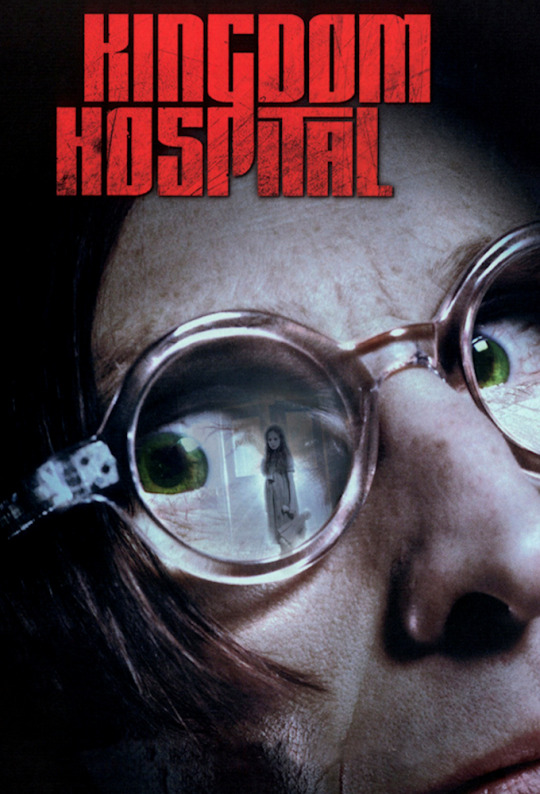
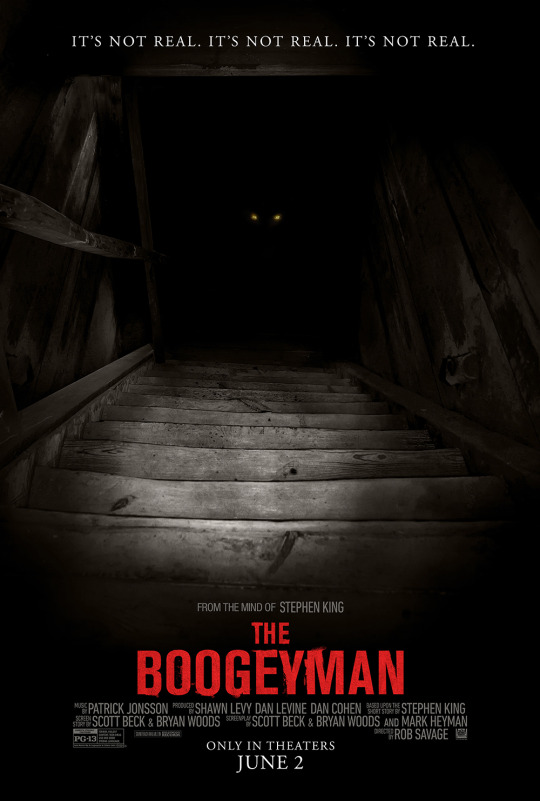



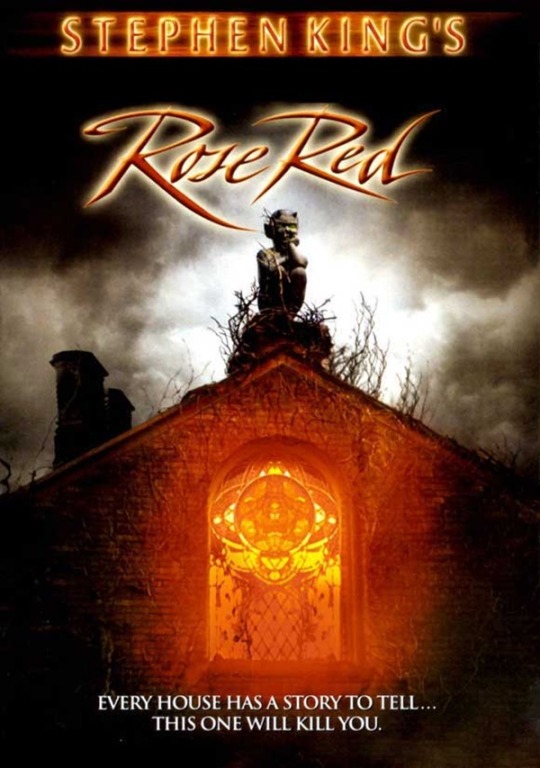

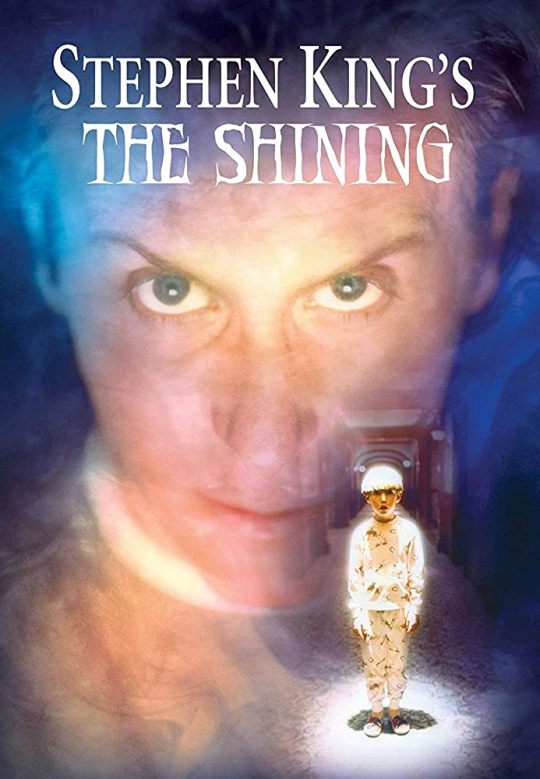


favorite stephen king adaptations/works
x kingdom hospital (2004)
x the boogeyman (2023) ---> the night shift (1978)
x storm of the century (1999)
x the green mile (1999) ---> the green mile (1996)
x the cat’s eye (1985) ---> night shift (1978)
x rose red (2002)
x it (2017) ---> it (1986)
x the shining (1997) ---> the shining (1977)
x thinner (1996) ---> thinner (1984)
x misery (1990) ---> misery (1987)
#stephen king#kingdom hospital#the boogeyman (2023)#the night shift#storm of the century (1999)#the green mile (1999)#the green mile#the cat's eye (1985)#rose red (2002)#it (2017)#it#the shining#the shining (1997)#thinner#thinner (1996)#misery (1990)#misery#books#movies#horror
36 notes
·
View notes
Text

#Stephen King#Creepshow (1982)#Creepshow 2 (1987)#Maximum Overdrive (1986)#Pet Sematary (1989)#Golden Years (1991)#Sleepwalkers (1992)#The Stand (1994)#The Langoliers (1995)#Thinner (1996)#The Shining (1997)#Storm Of The Century (1999)#Rose Red (2002)#Kingdom Hospital (2004)#Under The Dome (2013 - 2015 Tv Series)#S2E1#Mr. Mercedes (2017 - 2019 Tv Series)#It: Chapter Two (2019)
2 notes
·
View notes
Text
Since the 1960s, the world has seen a spike in the number of natural disasters, largely due to rising sea levels and an ever gradually increasing global surface temperature.
The good news? We’re getting better at helping each other when disasters strike.
According to a recent study from Our World In Data, the global toll from natural disasters has dramatically dropped in the last century.
“Low-frequency, high-impact events such as earthquakes and tsunamis are not preventable, but such high losses of human life are,” wrote lead authors Hannah Ritchie and Pablo Rosado.
To conduct their research, Ritchie and Rosado gathered data from all geophysical, meteorological, and climate-related disasters since 1900. That includes earthquakes, volcanic activity, landslides, drought, wildfires, severe storms, and mass floods.
In the early-to-mid 20th century, the average annual death toll from disasters was very high, often climbing to over a million.
For example, the study cites that in 1931, 2.7 million people died from the Yangtze–Huai River floods. In 1943, 1.9 million died from the Bangladeshi famine of 1943. Even low-frequency events had extreme death tolls.
“In recent decades we have seen a substantial decline in deaths,” Ritchie and Rosado observed. ��Even in peak years with high-impact events, the death toll has not exceeded 500,000 since the mid-1960s.”
Why has the global death toll from disasters dropped?
There are a number of factors at play in the improvement of disaster aid, but the leading component is that human beings are getting better at predicting and preparing for natural disasters.
“We know from historical data that the world has seen a significant reduction in disaster deaths through earlier prediction, more resilient infrastructure, emergency preparedness, and response systems,” Ritchie and Rosado explained in their study.
On April 6, [2024],a 7.2 magnitude earthquake rocked the city of Hualien in Taiwan. Days later, as search and rescue continues, the death toll currently rests at 16.
Experts have praised Taiwan for their speedy response and recovery, and attributed the low death toll to the measures that Taiwan implemented after an earthquake of similar strength hit the city 25 years earlier. Sadly, on that day in 1999, 2,400 people died and 11,000 were injured.
In an interview with Al Jazeera, Wang Yu — assistant professor at National Taiwan University — said that event, known as the Chi-Chi earthquake, revolutionized the way Taiwan approached natural disasters.
“There were lots of lessons we learned, including the improvement of building codes, understanding earthquake warning signs, the development and implementation of earthquake early warning (EEW) systems and earthquake education,” said Wang.
Those same sensors and monitoring systems allowed authorities to create “shakemaps” during Hualien’s latest earthquake, which helped them direct rescue teams to the regions that were hit the hardest.
This, in conjunction with stronger building codes, regular earthquake drills, and public education campaigns, played a huge role in reducing the number of deaths from the event.
And Taiwan’s safeguards on April 6 are just one example of recent measures against disasters. Similar models in strengthening prediction, preparedness, and recovery time have been employed around the world when it comes to rescuing victims of floods, wildfires, tornados, and so on.
What else can we learn from this study?
When concluding the findings from their study, Ritchie and Rosado emphasized the importance of increasing safety measures for everyone.
Currently, there is still a divide between populations with high gross national income and populations living in extreme poverty.
Even low-income countries that infrequently have natural disasters have a much higher death rate because they are vulnerable to collapse, displacement, and disrepair.
“Those at low incomes are often the most vulnerable to disaster events; improving living standards, infrastructure, and response systems in these regions will be key to preventing deaths from natural disasters in the coming decades,” surmised Ritchie and Rosado.
“Overall development, poverty alleviation, and knowledge-sharing of how to increase resilience to natural disasters will therefore be key to reducing the toll of disasters in the decades to come."
-via GoodGoodGood, April 11, 2024
#good news#hope#climate change#hope posting#climate news#climate crisis#climate anxiety#climate emergency#natural disasters#disasters#earthquake#wildfire#hurricane#cw death#taiwan#tsunamis#building construction#climate action#climate hope
459 notes
·
View notes
Text
| Fic inspired by: {Reverse 1999} A 20th Century Time-Travel Strategic RPG Game |







Noticing her turning to leave, you panic and grab onto her wrist. A vice-like grip around it, almost as if when she leaves . . . She’d disappear and take everything you hold dear with her.
“Timekeeper wait!”
Vertin’s head snaps to look at you. So quickly, you swear it flew. A mixture of intense emotions written all over her face. Eyes widened in shock with her mouth slightly agape. She’s been on many missions that‘s brought new arcanists to the foundation, but never has anyone clung to her in such a manner. Its the storm, Vertin tells herself, the storm is what’s causing you to act like this. Why else would you cling to failure like her who can’t protect anyone? But then she looks into your eyes . . . Eyes that peer up at her so vulnerably. Never has anyone looked at her with such fondness in their eyes. Never . . . Has anyone but her mother held onto her like she’s their lifeline.
“I-” You pull your arm back immediately, attempting to speak but the ability to speak has already left you. Apologies about to leave you, but she speaks up before you can even start. “Whatever it is that you wish to speak, you must be quick about it. The storm is almost here.” She speaks with finality in her voice. Ahh, another mission must have been assigned.
Embarrassed, your eyes wander away from her face as you fidget with yourself. “I- . . . Timekeeper, I know you’re busy. It’s not my intention to keep you from your duties . . .” Trailing off again, you’re unable to speak. “But?” She says in an attempt to coax it out of you. The authoritative tone melts away to a voice as smooth as butter, so you cave. Like you always do with her.
“I know that you've been through these many times.” You swallow trying to gather the courage to speak to her so boldly. Openly for the first time. She watches you with such intensity that you get lost in her eyes. The same aloof expression as always has captivated you like no other face could ever. This causes your soul to jump to the sky in fright when you feel her hand grasp yours. Tight and warm, yet her touch is so gentle. . . . As if to say she’s here for you. “With lots of other arcanists but . . . This is my first time braving through the storm. I know you're needed elsewhere but if it's possible . . . Please could you . . . Could I stay with you please?” Your voice teeters off meekly at the last sentence. Tears welling up in your eyes, but you blink them away as you pull your hand away from hers. Face turning away in shame. “I MEAN . . . Forgive me, I just got carried away. You should go before someone comes to-”
“I’ll stay.” Now it’s your turn to look shocked. Eyes finding hers again once more. The sad sea green ocean in her eyes moves you to huddle closer back to her. To comfort her, something tugs at your heart whenever her eyes get like that. Murky and dark, like she’s reminiscing on something that doesn’t exist anymore. Oh, how you wish you’d be allowed to know what goes on in her head. “I know what it’s like to be all alone with no one to turn to. Don’t worry about my mission, after all I'm not a timekeeper yet, so you shouldn’t keep calling me that either. My abilities are far too weak to be considered for high stake missions at the moment.” With that being said, she breaks your shared stare. An arm hesitantly wrapping around you. Looking outside the window, she observes the rain as it dances around the flowers outside the facility. “I’ll stay with you, as long as you need me to.” Those words bring you more comfort than anything the foundation could ever offer. And they have offered a lot. Your ability is a game changer. By getting to you first, they got the first real upper hand on manus vindicate but all you feel like is a puppet they poke and prod at.
Vertin on the other hand, feels like home. God, you haven’t thought of that in a long while. Wordlessly, you lean your head on her shoulder. She lets you.
Together the two of you watch the world outside as the number on her wristwatch gets closer and closer to zero. Abnormalities beginning to appear, and soon the storm will begin.
5
4
3
2
1
. . . Her hand clutches yours even tighter and a whimper is heard. You're not sure if it's hers or yours.



[ ᴅɪᴠɪᴅᴇʀꜱ ʙʏ: @grungenglam]
#=ᴄʜ: ᴠᴇʀᴛɪɴ🕰💼#irides writes 📝#reverse 1999#reverse 1999 x reader#reverse 1999 x you#r1999#r1999 x reader#r1999 x you#vertin#vertin x reader#vertin x you#reverse 1999 fluff#r1999 fluff#reverse 1999 x y/n#vertin reverse 1999#reverse 1999 vertin#reverse: 1999#Reader x vertin#Vertin x reader#Vertin#reverse: 1999 x reader#reverse1999#𝔗𝔥𝔫𝔵 𝔣𝔬𝔯 𝔯𝔢𝔞𝔡𝔦𝔫𝔤 𝔱𝔥𝔞 𝔟𝔩𝔬𝔤 💟✨
86 notes
·
View notes
Text
Reverse 1999: Text from loading screens on start-up
Let me know if I missed any. I kept restarting the game until I found these but there could be more. I used a text extractor to post the text as well as the picture since it's kinda blurry.

Modern era
It is only fair to say the 20th century is a good time. Parties, the millenium countdown, the Y2K panic, the 15-inch color monitor, and a sleepless night–we had it all.
But look back, my friend, for the past goes back far and leaves us so much to enjoy! Would you like a piece of gold?

Arcanum
An innate ability. A glow in you which may be dimmed but would never be erased. Strange effects come with it. Sometimes it is strong, sometimes it hardly exists, sometimes it is versatile, sometimes it only brings about bitterness and trouble.
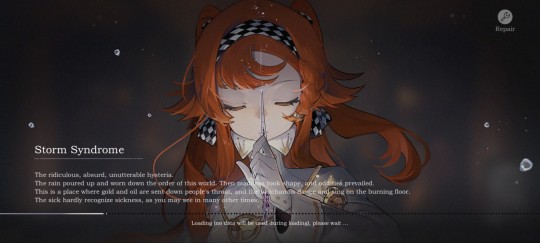
Storm Syndrome
The ridiculous, absurd, unutterable hysteria. The rain poured up and worn down the order of this world. Then madness took shape, and oddities prevailed. This is a place where gold and oil are sent down people's throat, and the bacchanals dance and sing on the burning floor. The sick hardly recognize sickness, as you may see in many other times.

Arcanist
A race forgotten and left behind by the progressing world because of their talent. The knowledge of when arcanists became arcanists is now lost in time. Once there were many of them, now there are few.
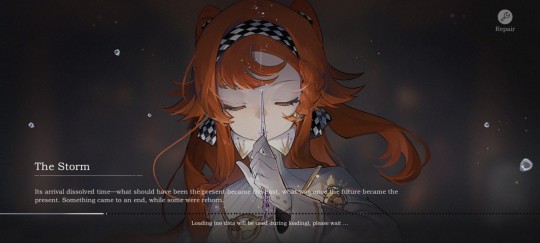
The Storm
Its arrival dissolved time–what should have been the present became the past, what was once the future became the present. Something came to an end, while some were reborn.
106 notes
·
View notes
Text

An aspect of this event that I really like is how it's spreading light on how humans interacted with actual Arcanist culture that was completely separate and different from human culture. Up until now, each event has really been about the separation of Humans and Arcanist thinking, in that they literally cannot comprehend the world in the same way. From the trailers alone, I kind of assumed that the Uluru games had just been cancelled due to the Storm, but it seems they fell out of popularity because the Foundation changed literally everything about them once they had control over it.
And really, I feel like there's no better allegory for cultural appropriation and colonization than that because it happens all the time in the real world as well. People take an aspect of one culture they're not apart of because they think it's cool, they change everything about it or misappropriate that part of the culture, and then they completely ditch it once no one from that original culture is engaging with what they've created because it's "lame" now or always was "lame".
I can't count the number of times I've seen white people take a dance or a song or a piece of actual vernacular from black people and run it into the ground or misuse it, only to stop using it once they have no interest in it (because the people they took it from also have no interest in it) and I feel like it's the same for these games and other things that Arcanists in Reverse 1999 made. Or how white people will butt their heads into a topic that specifically pertains to the black experience and give their very wrong and ignorant opinion on it, and then get mad when black people tell them that they're too misinformed to understand what the topic at hand really is.
And this part in particular with Ezra really just cements in me that the Arcanists probably had so many infuriating and annoying arguments with Humans back then when the Foundation wanted to just keep changing the rules of the games to be "safer".

Ezra is "technically" right that the blanket statement "Fire is dangerous" is correct. And the Arcanists know that "Fire is dangerous" but the Arcanists are not worried about it being dangerous. Not because they are foolhardy or illogical, but because they understand how it works and can control it and have their own methods and ways of using fire that humans just can't.
Arcanists have been doing their own thing for centuries, they don't need humans barging in and giving them a stern warning on fire safety especially since their warnings and lectures about fire safety would only apply to humans anyways. Humans definitely didn't care about that though, and most definitely insisted on changing everything because "its unsafe, and don't you WANT people to be safer during the games?" even if Arcanists have been safe for centuries in their own ways.
43 notes
·
View notes
Text
Going through Three Doors only to see Lucy unexpectedly mentioned (plus a small cameo). It seems like she's not very popular amongst employees at all haha. Interesting how the time difference between the two scrap papers is ~30 years (1863 -> 1891). Uhh let me think actually. The timeline is strange. Lucy was nominated as the leader of Laplace some time after the Storm of 1999, since the previous head got reversed, and no qualified candidates were available (information found on her CN wiki). I can't remember how many times forward we've moved, but mid to late 19th century is pretty far from where our story is so far 🤔 (1911(?)). Whatever, there are definitely more knowledgeable people than me on this topic (I remember reading a post about the confirmed Storm dates, but I can't find it for analysis 🥺)
Paper 1: A couple of Laplace employees use a piece of scrap paper to write notes to one another. The first paper details a missing steam engine + mention of a new high-ranking employee being sent from above. Going by their distaste for arcanists, they definitely seem to be humans. It seems they were caught by Lucy(?), so they stop on this paper. (Hairy Legs is such a funny alias 😂)
Old Scrap Paper I:



Paper 2: The Laplace employees continue to use scrap paper to make notes and chit-chat. They complain about Lucy, her battery obsession, and her management. It seems that Lucy treats her employees like machines LOL (just reeking, starving, and ridiculously punctual machines...). Lucy catches them writing again, and decides to help them out by telling them how to submit their transfer requests.
Old Scrap Paper II:




I must say, fearing management being arcanist is not exactly unfounded 😭, they are pretty scary, moreso when said arcanist is a literal machine.
21 notes
·
View notes
Text




Storm of the Century (1999)
8 notes
·
View notes
Text
Germany’s former head of domestic intelligence, Hans-Georg Maassen, recently announced he would be suing the agency he used to lead for using its powers to “observe government opponents.” That is to say, for surveilling him.
The initial revelation, about Maassen being monitored by the very intelligence agency he had once led, arrived in January. He accused the agency of abusing its power to “politically persecute government critics.” “In doing so, they are seriously violating their official duties and thus damaging liberal democracy,” he recently said. “Opponents of the government are not enemies of the constitution.”
But the two are not mutually exclusive. Maassen, who the Süddeutsche Zeitung called the “Steve Bannon of Thuringia,” is well known for nationalistic, far-right rhetoric. He has denounced what he calls “racism against whites” and lamented “massive migration,” which he believes has led to “parallel societies,” the “dissolution of family and local relationships,” and a threat to “national cultures.” He’s also decried “migrant clans that are active in organized crime.” (In fact, immigrants in Germany commit far fewer crimes per capita than native Germans do.) “Only nations made up of free citizens who share a common culture and rule of law,” Maassen wrote in 2020, “manage to live in internal and external peace.”
“This is typical right-wing populist rhetoric. Hans-Georg Maassen is part of the new-right milieu,” said journalist and historian Volker Weiss. “Imagine—he became president of the Office for the Protection of the Constitution to clean up after the NSU,” in reference to the National Socialist Underground, a far-right terrorist group that murdered and bombed immigrants in towns and cities across Germany from 1999 to 2011.
But Maassen may have done more than brush shoulders with members of Germany’s far right—he stands accused of colluding with them, too. Spiegel reported that in 2015, Maassen met with Alternative for Germany (AfD) leader Frauke Petry for the purpose of helping her avoid scrutiny from the very agency that he led. According to Spiegel, Maassen was also in contact with a far-right extremist who was part of a plot to overthrow Germany in a coup. In December 2022, some 3,000 police and special forces officers raided 150 properties across the country and arrested 25 far‑right extremists associated with the Reichsbürger movement who planned to storm the Bundestag, assassinate Germany’s chancellor, and install a military regime.
These were no average citizens or small‑time soldiers. One had served in the Bundestag as a legislator for the AfD and was a standing judge at the time of her arrest. Another served in a paramilitary police unit. Another, a conspiracy theorist named Heinrich Reuss, was a Thuringian aristocrat who prosecutors say planned to install himself as Germany’s new leader. Maassen allegedly sent a birthday message to the far-right author Markus Krall, who is suspected of plotting to become finance minister in the new government post-coup. “We must keep fighting,” Maassen wrote in his message to Krall after the plot was thwarted.
As the former president of the Office of the Protection of the Constitution, Maassen ought to have been the last person in Germany to cheer on an alleged member of a plot to overthrow the country’s democratic government. And yet, for close observers of Germany’s intelligence agencies, the news wasn’t as shocking as it appeared. Maassen wasn’t Germany’s first intelligence chief to be accused of holding far-right views.
In the 1990s, a right-wing extremist named Helmut Roewer headed the regional intelligence agency in Maassen’s state of Thuringia. Roewer’s agency employed numerous far-right informants and nonetheless failed to prevent the deadliest far-right extremist plot in 21st-century Germany, the Thuringia-born NSU. Part of the reason for that failure was that Germany’s intelligence agencies were still employing some of the same tactics of the Gestapo and even the Stasi by employing a large network of informants. Critics of these agencies allege that rather than merely monitoring or infiltrating movements run by far-right extremists, by placing so much cash and confidence in them, agencies are funding and fostering those scenes instead.
This, to be sure, is what Roewer’s agency did. He would eventually admit that relying on far-right informants had gone horribly wrong. “Recruiting skinheads was an absolute disaster. They get drunk, then say they couldn’t remember anything,” said Roewer, who admitted to Thuringia’s state Parliament that he sometimes did the same. And yet, knowing this didn’t stop Roewer from recruiting them. (Roewer left in 2000 while under investigation for allegedly funneling state money into his private accounts. He became an outspoken conspiracy theorist, asserting that the NSU murders were in fact the work of a liberal “deep state” for which far‑right extremists were framed in order to make Germany look bad. He declined my interview request.)
One of his agency’s far-right informants was a man named Tino Brandt who helped indoctrinate some of the people who would later form the NSU. Brandt estimated that Roewer’s agency paid him some 200,000 taxpayer Deutsche marks over the years—worth about $115,000 at the time. Brandt later testified that he’d invested much of the money back into the very far‑right scene that the intelligence agency was employing him to watch. For all the agency’s claims about how indispensable he was as an informant, Brandt testified during the NSU trial that he never compromised a single comrade—“I never put anybody in jail.”
In fact, the agency had to move mountains to keep Brandt out of jail himself. According to Thuringia’s Interior Ministry, police suspected him of at least 35 crimes relating to his far-right organizing in Thuringia, but a Thuringia state legislator who investigated Brandt, Katharina König, told Foreign Policy that Roewer’s agency “stopped all their cases against Tino Brandt in order to save their spy.” On one occasion, an intelligence agent tipped Brandt off that police intended to search his computer for incriminating evidence the following day. When Brandt handed over his computer, something was missing: the hard drive. Brandt had removed it. He was “grinning from ear to ear,” an officer who was there told Thuringia’s NSU investigative committee.
By subverting justice to protect far-right extremists, Germany’s so-called Offices of the Protection of the Constitution undermine it instead. Nothing exemplifies German intelligence agencies’ paradoxical relationship with far-right informants better than what happened in 2011, when the NSU came to light. That very week, a clerk at Germany’s federal intelligence agency in Cologne began feeding documents into a shredder, German news media later reported. At first, she’d refused to do it. But when she was told the order came from the top, she obliged.
In 2012, German media revealed that the documents were part of an operation to recruit far‑right informants from 1996 to 2003—a period that overlapped the NSU’s terrorist spree. The revelation caused a national scandal. Because the shredding occurred in Cologne during the city’s famous Carnival celebrations, during which confetti is thrown into the air in celebration, the media began referring to it as “Operation Confetti.”
Three days after the shredding, German intelligence agencies destroyed even more potential evidence—six transcripts of telephone calls that they’d recorded between members of the far right. This time, the order came from even higher: Germany’s Ministry of the Interior. Some newspapers reported that the files pertained to an operation to recruit right‑wing informants in Zwickau, the city in Saxony where the NSU had been hiding.
Officials swore that the files were destroyed as part of a routine procedure because they were more than 10 years old, insisting they had nothing to do with the NSU. But to the families of those that the NSU murdered, the timing suggested that authorities may not have been merely negligent for having failed to stop the killings, but also complicit in covering them up.
The case also raised enormous questions about the types of informants that these agencies were employing. One former intelligence officer in the state of Hesse, Andreas Temme, was almost certainly present at the scene of one of the NSU’s immigrant murders. He later told police officers that he wasn’t. Police searched his apartment as well as his room at his parents’ place, where he sometimes stayed. They discovered sheets of paper with quotes from Adolf Hitler’s Mein Kampf and other Nazi literature, including copies of an SS handbook that Temme had typed up by hand. His neighbors told police they called him “Little Adolf” on account of his far‑right views.
In the NSU’s aftermath, the head of Germany’s federal intelligence agency resigned. And of all people, Maassen was the man that former German Chancellor Angela Merkel and her cabinet choose to take his place.
Maassen was a controversial choice for the mission of revamping an agency that had failed to see or stop Germany’s most sensational anti-immigrant plot of the 21st century. As a lawyer for Germany’s ministry of the interior he earned a reputation as being anti-immigration, mostly notably due to his decision that a German resident of Turkish citizenship named Murat Kurnaz should not be allowed to return to Germany because he’d violated his immigration terms by remaining outside Germany for more than six months–while being unlawfully held and tortured at Guantanamo Bay.
Six years into his tenure, his far-right bias would be his undoing. He was forced out after he downplayed the far-right riots and attacks against immigrants in the city of Chemnitz in August 2018. The riots started after a 23-year-old Syrian refugee, Alaa S., stabbed and killed a 35-year-old German carpenter at a city festival. The resulting anti‑immigrant protest organized by the AfD in Chemnitz devolved into white Germans attacking immigrants in the streets while police struggled to maintain control.
“As the head of Germany’s anti-extremist intelligence agency, Maassen’s job was to investigate the shocking images coming out of Chemnitz, especially after Merkel condemned protesters for ‘hunting’ foreigners,” wrote the Berlin-based political journalist Emily Schultheis. “Maassen did the opposite,” she added, refusing to treat the white German perpetrators as a threat.
In doing so, critics allege Maassen neglected his fundamental duties to protect Germany’s people—in this case, its immigrants—from violent, anti-democratic threats. Sure enough, a few weeks after the riots, eight white men formed a group that they called “Revolution Chemnitz” and began attacking immigrants with baseball bats in a Chemnitz park.
Complacency like Maassen’s has enormous implications for Germany’s ability to protect immigrants today. Last year, Germany saw some 2,300 attacks against refugees—more than any time since the so-called global refugee crisis began. Police and, to a lesser extent, intelligence agencies are failing to prevent thousands of far-right extremist attacks against Muslims, immigrants, and Jews—a failure that cannot easily be corrected if the heads of Germany’s security agencies are run by far-right men such as Maassen who sometimes refuse to see the threat.
In 2022, Germany counted at least 327 far-right extremists working in its military, intelligence, and police. In April, the German paper Stern reported that there were some 400 cases pending against state police officers for espousing or acting upon far-right extremist beliefs.
“If you have criminal activity among your own people, it’s very hard to detect it,” the president of Thuringia’s intelligence agency, Stephan Kramer, told Foreign Policy. “It’s very hard to go after it. And it’s very hard to break.’”
“Right-wing terrorism—or right-wing extremism—is the major subject that we’re dealing with,” Kramer added—but it isn’t new. “The blood trail of right-wing extremism-slash-terrorism has existed as long as the federal republic of Germany, and for a very long time it was played down by the security agencies focusing, for their own political reasons, on other stuff—for example communism, left-wing extremism,” Kramer said, adding, “If you look at the blood trail that neo-Nazism and right-wing extremists in Germany have left since the beginning of the 60s and 70s—and the numbers of victims killed by them—there was never a time when there was not a vital threat from the right-wing.”
“Yes, the intelligence community … made grave mistakes—even collaborated with the extremists that they were supposed to fight against,” in the case of the NSU, Kramer said. “Mr. Rower, one of my predecessors who was the head of the whole conspiracy—yes, he did that. No question about it.”
But Kramer insisted that intelligence agencies cannot keep the public safe without employing far-right moles. “All the old informants during the time of the NSU were taken out of business”—including people such as Tino Brandt, Kramer insisted.
But the NSU scandal wasn’t the only occasion that Germany’s proliferation of far‑right informants has backfired spectacularly. Months before 9/11, in January 2001, German legislators and cabinet members under then-Chancellor Gerhard Schröder petitioned Germany’s highest court to ban the country’s neo-Nazi NPD party on the grounds that it sought to overthrow Germany’s democratic order.
But in March 2003, the court rejected the ban for a revealing reason: Germany’s intelligence agencies had recruited and funded so many informants within the party’s ranks—some 30 of the NPD’s 200 leaders, or one out of every seven—that the court couldn’t discern which of the party’s anti-constitutional ideas belonged to its genuine members, and which belonged to government spies.
This should have been a stark and humiliating lesson about the overuse of informants. But whenever intelligence chiefs and their informants share some of the same right-wing beliefs, the lines between mole and minder blur.
But to Maassen, contrary to what Kramer told me, Germany’s intelligence agencies were never “blind in the right eye”—that is to say, blind to far-right threats, as the German saying goes—but in the left. It took the Chemnitz riots to force Germany’s leaders to acknowledge that Maassen’s eyes were shut.
And yet, in the deal that orchestrated his ouster in 2018, the CDU gave Maassen a pay raise and a promotion to deputy interior minister. “It’s absolutely irresponsible to promote him to an even better job with even more power than now for a failure and for spreading conspiracy ideas,” said Quent, the aforementioned scholar, at the time. Maassen was ousted from that role less than two months later, but his political ambitions were far from through. In 2021, he ran for a seat in the Bundestag and lost.
In early 2023, Maassen was elected president of a small, far-right union, from which his present political ambitions emerged. This January, he announced plans to waylay the organization into his own political party, the Values Union, to compete in Germany’s September elections in three key, right-leaning federal states.
Such new, identity-cult political parties are in vogue: That same month, a former Die Linke faction leader in the Bundestag, Sahra Wagenknecht, launched her own, narcissistically named party, Bündnis Sahra Wagenknecht, to draw anti-immigrant voters from the left. While most opinion polls place her at 5 percent to 8 percent nationally, one recent poll estimated the number of eastern Germans who would consider voting for her in this September’s state elections as high as 40 percent.
It’s too early to predict whether Maassen’s party could seriously contend in September’s state elections in Brandenburg, Saxony, and his home state of Thuringia. But the former spy chief intends to try.
“We will do everything we can to ensure that there will be an anti-socialist turnaround in Thuringia next year,” he warned in a recent post on X.
Maassen did not grant a request for interview.
6 notes
·
View notes
Text
First Impression of Reverse: 1999 from a Long Time Gacha Games Player

Hello! Today I'll tell you my first impression about a new gacha game that just release it's global version not too long ago, "Reverse:1999". I preregistered this game and mind you, I actually had zero intention to add more gacha games into my sleeves especially the turn-based ones, but the art... The ART man!! It caught my attention soo let's dig in!
Before we start I'd like the readers (you) to know that I've been playing gacha games daily for a considered long time, since 2017 and still going on today. Although not a lot of them so here are some that I've played for over 3 months (pretty much understand the overall system):
Fate/Grand Order, Arknights, Genshin Impact, Honkai/Star Rail
Bold are my main daily games. And then here are some that I've tried, well at least I know their UI & prologue lol:
SAO MD (discontinued), Food Fantasy, Granblue Fantasy, Punishing/Gray Raven, Tower of Fantasy
I might bring up some titles to compare and most likely from between the "over 3 months" ones. Then, let's start!
What's the big deal of "gacha game" and why I play them?
I like to draw and gacha games have one of the best community for art clout. No this is serious, and one of my top reason of why I'm playing this borderline gambling type of game.
Gacha games are living from their banner rotation. The second ones are new characters and story reveal that updated regularly... Don't you think these are real good timings for posting?? They also got those art gods that somehow helped the promotion and attract the peasants (me included) to get to know the story and make fanarts too. I'm not kidding. This is why I've been here since I started digital art. Lol.
But every actions need consequences. Gacha games are very high maintenance to stay relevant, from the player's side. You missing one update, you'll feel like an old man. This is the most FOMO (fear of missing out) type of game. The main sacrifice is TIME. So many things need to tend in one game, and if you play multiple it means you have to spare some hours in a day. If you can't, get ready to lose something. Why I don't say money? Because I'm pretty much f2p, I never really spent my money for gacha. But time, time bro. Time also money! This is also why I write this post.
The Premise of Reverse: 1999
The early story kind of reminds me to Persona 3 where there are some special times (Dark Hours in P3) where an ordinary human can't survive and there are some special creatures than survived.
In R:1999 the special time is called "storm" which will turn back time further from your original time. For example, MC is from 1999 but she's sent to 1920s thanks to the storm. So they made a foundation or something to get back to the original time. Well in a sense this is kinda similar to FGO (Fate/Grand Order)'s Chaldea, maybe that's why I'm so driven to try this game lol. The name of those "special creatures" are arcanists.
Actually I don't really understand everything yet, but at least that's the glimpse I got. Also they tried to fix the history or something whenever they're getting sent back so, basically a fancier FGO right?? I have no problem though.
Setting
The game's mainly set in the west in 20th century. I think this is the main perks of the game, because the entire design and aesthetic revolves around this so it can differ greatly from most gacha games that either have fantasy RPG setting or urban post/apocalyptic ones. Personally I really like this.
The Main Character
The MC is such a breath of fresh air!! It's a woman, and people called her "Vertin". So no, not your typical self-insert anime degenerate persona like most gacha games. Here is a very beautiful EP of her:
youtube
The Characters
The characters are pretty unique imo, you can play as inanimate object (visually) like apple and satellites. The arcanists are the playable (and summonable) characters. So expect to see various 20th century-themed designs.
Also the designs are dope!! They're unlike most gacha games' characters designs where they wore something weird that will awaken your darkest corner of brain but here they're just dressed NORMALLY LIKE A NORMAL FANCY PERSON I'm so glad. Normal doesn't mean boring, this is a compliment. Even the "fanserviced" ones are still pretty tasteful than just put random windows everywhere.
Summoning
This game has a carry-over pity on 70th roll, soft pity started like in the 60th. They use the same gacha currency on both permanent and limited banners. There's 50/50 like in Mihoyo games. You need 180 clear drops (?) to turn them into one rabbit statue (?) for a summon. I think this one is very similar with Arknights. Personally in my opinion this is very generous and reasonable, but I'm a FGO player so yeah my "generous" standard may differ greatly with a lot of people lol.
Oh you also can get guaranteed *6 from beginner's summoning banner.
(Early) Gameplay & Progression
The gameplay is like FGO with extra steps. Or FGO with fewer steps... Anyway, it's a card game. Each character has cards you can choose per turn. Once the "stars" are filled you can unleash the ultimate. Honestly? A little boring lol, but things may change once I get out early-game phase. People said this is very similar to 7 Deadly Sins game but I never get close to the IP so idk.
You can set which enemy to hit per card unlike FGO where it's done per turn. Personally I think this is neat. Although among the games I've tried I think Honkai/Star Rail still superior for turn-based system since they can control the speed and whatsoever. However this kind of "fixed" system also nice since you don't need to farm artifacts/relics to be playable.

The early stages are so easy. Well, most games have very easy early stages though, unless a certain popular furry tower defense game (*cough* Arknights *cough*).
For character progression pretty much just level up, no need for artifacts/relics like Mihoyo games so it's fast and easy.
You can set a "replay" for autofarming once you get 2 stars achievement on the node. You can also choose the "amount" of drop rate for just one battle. This is very neat!
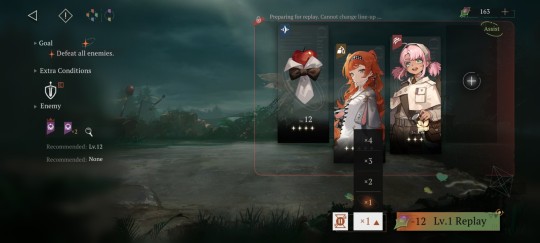
Dailies, Weeklies, etc
R:1999 has similar progression with Arknights and Mihoyo games with this one. The daily and weekly tasks literally like Arknight's.

Tbh their dailies are quite a hassle lol, you need at least spend 5-15 minutes to clear all.
And their "battlepass", looks like Genshin's battlepass or HSR's Nameless Honor
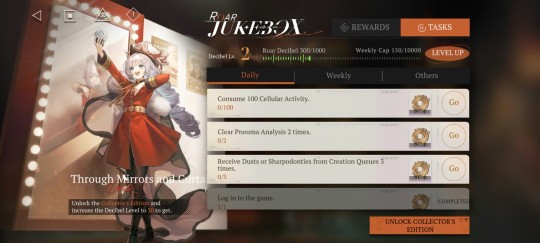

Gotta admit between ALL the games I've played, nothing beats the simple daily of LOGIN in FGO (in exchange with disastrous gacha and tremendous farming🙏).
UI & Visual
Maybe I should've put this a little earlier lol.
The UI is AMAZING!! One of the best. Really (once again) reminds me of Arknights, since I like their UI too, and even better I think especially their retro aesthetic.
The visual is GORGEOUS. The game is presented in common gacha game storytelling method: visual novel, however they tried to incorporate like L2D animation in the STORY'S VISUAL.
The characters have different art styles, I think done by different artists like most gacha games (the only one who didn't do this are Mihoyo games, please explain). And the sprites are full body non-chibi 2d animations! This one's like FGO, although still like 10% chibified so in terms of sprite style, FGO still has the crown.
Music & other sounds
Music is BANGER!
I rate it 4.5/5. Maybe the 2nd music of gacha games that I like after Genshin. It doesn't sound like basic visual novel ost (looking at you FGO and HSR) in most part, tho since this is basically *still* visual novel, so in some part still sounds pretty stale after you heard it so many times.
The voice over is dope! They used various accents, so it's pretty interesting!
Housing/Dorm
The name of housing/dorm in R:1999 is "Wilderness", something like islands. This is once again reminds me to Arknight's "Base" but outdoor.
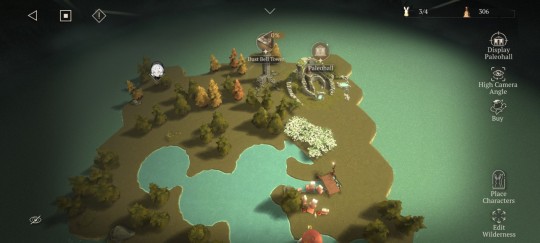
End game
Honestly I haven't found the endgame content for this one, if you're looking for challenges maybe games like Arknights and HSR still better choice.
Conclusion
Based on every gacha games I've played, I can say progression, UI, and summoning from Reverse:1999 is similar to Arknights, but turn-based and A LOT easier at the start. If you've played Arknights before I think understanding the system will like walk in the park.
For the story it's somewhat like FGO, of course not the same, but still both are "correcting the history and go back to our time" kind of story.
The game doesn't ask much, so I think if you're a gacha game player and barely have any time for more games, this one's still enjoyable with very minimal investment. Suitable as your 2nd, 3rd, or even 5th gacha games. Especially when you're just want to vibe with the art and setting like me.
If you're new in gacha game, there's no problem with trying out this, but I think the game is made with thought that the target market are people that familiar with gacha games. Still, enjoy your time!
Tl;dr if you still want to play your main games daily while join the Reverse:1999 bandwagon, it's totally possible without sacrificing much of your time.
17 notes
·
View notes
Text
Stats from Movies 1001-1100
Top 10 Movies - Highest Number of Votes

Pet Sematary (1989) had the most votes with 921 votes.
I Know What You Need (2023) had the least votes with 310 votes.
The 10 Most Watched Films by Percentage
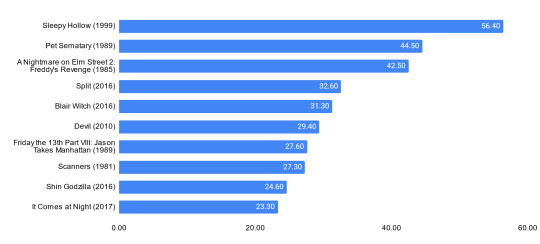
Sleepy Hollow (1999) was the most watched film with 56.4% of voters out of 424 saying they had seen it.
Saint Drogo (2023) had the least "Yes" votes with 0.2% of voters out of 495.
The 10 Least Watched Films by Percentage
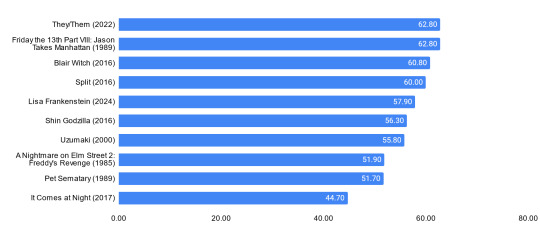
They/Them (2022) was the least watched film with 62.8% of voters out of 682 saying they hadn’t seen it.
I Know What You Need (2023) had the least "No" votes with 5,2% of voters out of 310.
The 10 Most Known Films by Percentage

Pet Sematary (1989) was the best known film, 3,8% of voters out of 921 saying they’d never heard of it.
The 10 Least Known Films by Percentage

I Know What You Need (2023) was the least known film, 94.2% of voters out of 310 saying they’d never heard of it.
The movies part of the statistic count and their polls below the cut.
What Josiah Saw (2021)
It Comes at Night (2017)
Something in the Dirt (2022)
Lisa Frankenstein (2024)
The Toxic Slime Creature (1982)
The House of the Devil (2009)
The Dark and the Wicked (2020)
Shin Godzilla (2016)
Run (2020)
Nine Dead (2009)
The Addiction (1995)
The Guardian (1990)
Open 24 Hours (2018)
Here Comes Hell (2019)
Sweet Home (2015)
Like Dogs (2021)
The Stylist (2020)
Saint Drogo (2023)
Girl on the Third Floor (2019)
Evil Bong (2006)
The Hunger (1983)
Sorority Babes in the Slimeball Bowl-O-Rama (1988)
Sorority Babes in the Slimeball Bowl-O-Rama 2 (2022)
Bed Rest (2022)
Witchhammer (1970)
Leonor (1975)
Cold Skin (2017)
The Vourdalak (2023)
Blood for Dracula (1974)
Flesh for Frankenstein (1973)
The Diary of Ellen Rimbauer (2003)
The Dirties (2013)
The Vigil (2019)
Storm of the Century (1999)
Infinity Pool (2023)
The Final Wish (2018)
Devil (2010)
Uzumaki (2000)
Horror in the High Desert 2: Minerva (2023)
Blood Red Sky (2021)
The Finale (2023)
The People Under the Stairs (1991)
Eli (2019)
Autopsy (2008)
Sleepy Hollow (1999)
The Gay Bed and Breakfast of Terror (2007)
I Walked with a Zombie (1943)
Paganini Horror (1988)
Titane (2021)
Burying the Ex (2014)
They Remain (2018)
Vicious Fun (2020)
Vivarium (2019)
Hell House LLC II: The Abaddon Hotel (2018)
Hell House LLC III: Lake of Fire (2019)
Summer of '84 (2018)
A Nightmare on Elm Street 2: Freddy's Revenge (1985)
Sweet Sixteen (1983)
Popcorn (1991)
April Fool's Day (1986)
Eerie (2018)
Friday the 13th Part VIII: Jason Takes Manhattan (1989)
Greener Grass (2019)
The Innocents (2021)
Dark Harvest (2023)
Häxan (1922)
Dark Light (2019)
Arthur, Malédiction (2022)
Polaroid (2019)
Antisocial (2013)
Headless Horseman (2007)
Radius (2017)
Goblin (2020)
Havenhurst (2016)
The ABCs of Death (2012)
Abandoned Dead (2015)
Pet Sematary (1989)
Dark Water (2005)
Hell House LLC Origins: The Carmichael Manor (2023)
Witches Straight From Hell (2023)
Belzebuth (2017)
Fade to Black (1980)
Scanners (1981)
Blood Punch (2013)
Cannibals and Carpet Fitters (2017)
Split (2016)
Game of Death (2017)
Paperhouse (1988)
The Baby (1973)
Splatter: Naked Blood (1996)
A Perfect Child of Satan (2012)
Blair Witch (2016)
Night of the Devils (1972)
I Know What You Need (2023)
Midnight Son (2011)
Slaxx (2020)
They/Them (2022)
The Darkness (2016)
Wind Chill (2007)
Crypt of the Vampire (1964)
11 notes
·
View notes
Text
youtube
Song Review: James Taylor - “Wasn’t that a Mighty Storm” (Live, Aug. 1, 1999)
With so many self-written must-plays in his pocket, James Taylor must choose his covers carefully. And when he pulled out the traditional “Wasn’t that a Mighty Storm” in the late-20th century, it was clear Taylor did so with extreme care.
The Aug. 1, 1999, performance at the Cambridge Folk Festival is the latest video release from Taylor’s archive. It finds him in a playful mood, doing his self-deprecating, bluesman shtick and giving ample room for guitarist Bob Mann, singer Arnold McCuller and keyboardist Clifford Carter, on accordion, to shine.
It’s a side of Taylor that comes out only occasionally on record and stage, but has a nearly perfect batting average. Whether that’s due to Taylor picking his spots or just because he’s so adept at the surprising persona is a mystery that’ll likely never be solved.
Grade card: James Taylor - “Wasn’t that a Mighty Storm” (Live - 8/1/99) - A-
8/22/24
4 notes
·
View notes
Note
hello there i have finally slept but woke up at 2;00 am what do i do
warning: rant fuelled by one (1) cup of jasmine tea, Re1999 brainrot, and a weirdly good 5 hours of sleep idek if half of the people on this blog know what Re1999 is
anyways thinking of ReM! MC getting isekai^2 (at least not cubed) into the Reverse 1999 world because. time-reversing storm exists and uhm St. Pavlov Foundation being eerily similar to the SCPF (LITERALLY ONE LETTER OFF)
assuming that MC reverses time when they die, and storm unaffected areas n devices are also unaffected by MCs time-reversing dying (because maybe they work the same way), Timekeeper and her harem the gang would probably detect and think they're a unique arcanist (also thought that they're maybe working or the manus vindictae??) and investigate them despite MC technically being human by blood and they're trying not to die via storm syndrome (i like to think it still affects them because the imagery of MC eating a brick of gold nonchalantly is fun)
MC takes off a Manus Vindictae member's mask (it looks cool) and the member dies (storm is happening rq), MC is like "woopsies"
if MC told Timekeeper the whole dying thing she probs wouldn't bat an eye cuz. arcanists are wild (she's gonna take interest in the way MC affects time because the only thing that reverses time is the Storm so far) (correct me if im wrong cuz i haven't seen the new chapters and event stories since math scares me and wdym there's a whole island of math ppl) maybe the SPF would experiment on them like they did with Timekeeper
MC joins team Timekeeper since free living place and no more eating money and the only thing you have to do is go on missions sometimes
MC offhandedly mentions liking horror once and now Horropedia is zooming down the halls trying to talk to them about FNaF lore (SCOTT CAWTON IS AN ARCANIST AND MADE FNAF BEFORE THE YREAR 1999 TRUST ME) (or the SPF got the internet past the 21st century somehow and he secretly downloaded the games and all the game theories idk, the new event takes place in 2007 so)
Click and MC bonding over experiencing death (+Necrologist for obvious reasons including death)
MC meets the Fool and mentions that he reminds them of someone
thank you for coming to my TED talk. It is 2:47 am here. I will actually go to sleep now
(I've been on this blog for a long, long time now. It's actually the reason I made a Tumblr account. thanks for introducing me to this small community of reader-insert SCP isekai with death-defying powers :D. can I be sleep-deprived anon :3)
Welcome sleep deprived anon :))
Alskjfa idk stuff about reverse 1999 but I might get around to it
#uhhh both my wifey and best friend have recced it#ask#Anomalous AU#sleep deprived anon#mumblings#answered#reverse 1999
8 notes
·
View notes
Text
Sci-Fi Saturday: Haredevil Hare and Rocketship X-M

Week 25:
Film(s): Haredevil Hare (Dir. Charles M. Jones, 1948, USA) and Rocketship X-M (Dir. Kurt Neumann, 1950, USA)
Date Watched: 2022-01-14
Viewing Format: Blu Ray for Haredevil Hare, DVD for X-M
Rationale for Inclusion:
I don't recall at what point I remembered that select Looney Tunes shorts needed to be included in this survey. Either the Fleischer Superman shorts by virtue of being animated, or Buck Rogers because of it reminding me of the parody short Duck Dodgers in the 24½th Century, made me realize that we needed to include the shorts featuring Warner Brothers' iconic alien Marvin the Martian.
Marvin appeared in five shorts during the classical period of Looney Tune animation, beginning with Haredevil Hare (Dir. Charles M. Jones, 1948, USA) and concluding with Mad as a Mars Hair (Dir. Charles M. Jones and Maurice Noble, 1963, USA). Of these shorts we only will be including two in the survey, and what better to start with than Haredevil Hare?
But wait, that short is from 1948 and we are squarely in the 1950s now. Why wasn't it watched earlier? Honestly, because it did not pair as well with any of the films of the 1940s in the survey as it did with this week's feature film Rocketship X-M [AKA: Expedition Moon and Rocketship Expedition Moon] (Dir. Kurt Neumann, 1950, USA), as they're both about experimental rocketships that end up on Mars. They're also closer together in creation than Haredevil Hare is to Invisible Agent.
As to why Rocketship X-M made it onto our survey, it was the first post-World War II space adventure film released, beating George Pal's Destination Moon (Dir. Irving Pichel, 1950, USA)--which will be next week's film--to release by a month in 1950. Much like The Flying Saucer (Dir. Mikel Conrad, USA), despite achieving a first for the genre, it has largely been overshadowed by later films. Rocketship X-M also has the indignity of being the first film of the survey to have later been mocked on the television series Mystery Science Theater 3000 (Dir. Jim Mallon, et. al., 1988-1999, USA).
Reactions:
Like basically every Warner Brothers short that Charles M. "Chuck" Jones directed, Haredevil Hare is a quality short, in terms of its animation, pacing and humor. Bugs Bunny plays the role of reluctant astro-rabbit before lapsing into his usual trickster self when the Earth is threatened with annihilation by Marvin the Martian. The majority of the short's action takes place on the moon, which has standard gravity and oxygen for narrative convenience. Frankly, it would be more surprising if this cartoon attempted to depict realistic space flight and lunar conditions than it is that Jones and his team couldn't be bothered to engage with known reality more than necessary.
As for Marvin, he looks as audiences have come to expect him to: in his Roman inspired attire since his home planet is named after their god of war. Mel Blanc's characterization for Marvin is more nasal than what his voice would be in the later shorts. I also was amused to see his trusty dog K-9 appear in this originating short. I thought he did not appear in a later short.
Like Bugs Bunny, the crew of Rocketship X-M is bound for the moon and has an aggressive encounter with a Martian. Unlike Bugs, their Martian encounter actually occurs on Mars, after a meteor storm forces them to recalculate their fuel ratios and they end up off course.
Despite it being a long passé technique, the scenes on Mars are tinted red in the otherwise black and white movie. The fact that Martian civilization went from an "Atomic age to a stone age" and is now a post-apocalyptic tribal society seems to be influenced by H.G. Wells' 1895 novel The Time Machine, and marks the first time an atomic powered apocalypse was referenced in a major motion picture. The presence of atomic destruction is attributed to the blacklisted screenwriter Dalton Trumbo, who acted as an uncredited script doctor on that sequence.
While the Mars sequence is definitely in the realm of soft sci-fi, some realistic elements are featured in the film. Rocketship X-M features a spaceship composed of multi-stage rockets, as would later be used in the real life American and Soviet space programs. The filmmakers apparently copied its design from illustrations featured in a January 17, 1949 issue of Life magazine, which is likely why that aspect of the film is more true to life than other parts. Less accurate is the haphazard depiction of microgravity, as some items are affected by weightlessness, but not everything that should be. The attempts at hard sci-fi seem to be dependent on if the filmmakers thought it was interesting, or within the special effects budget.
Nevertheless, Rocketship X-M set other precedents for atomic age sci-fi films.
The film's score by Ferde Grofé features the unique electronic tones of a theremin in places. While the instrument had been featured in film scores as early as 1931 in the Soviet Union, it was Miklós Rózsa's scores for Hollywood films in the 1940s that brought it to the attention of his colleagues in the American film industry. Despite being the first sci-fi film to make use of the theremin, two films that followed Rocketship X-M, The Thing From Another World (Dir. Christian Nyby, 1951, USA) and The Day the Earth Stood Still (Dir. Robert Wise, 1951, USA), would be the examples that cemented the instrument's connection to the genre in general and atomic sci-fi specifically.
Rocketship X-M also re-introduces the lady scientist love interest to the genre. Prior to Dr. Mary Robinson (Janice Logan) in Dr. Cyclops (Dir. Ernest B. Schoedsack, 1940, USA), the women love interests working with the male scientist main characters were merely assistants. A fully independent lady scientist, like Dr. Helen Jackson in Son of Ingagi (Dir. Richard C. Kahn, 1940, USA) was, and to a large extent remains, unthinkable in a mainstream Hollywood production. So for all her accomplishments, like being the developer of the mon-atomic hydrogen fuels that power the R-XM, Dr. Lisa Van Horn (Osa Massen) is in Rocketship X-M to mostly be a hetero-disclaimer for the ship's pilot Col. Floyd Graham (Lloyd Bridges).
When it comes time to implement a new fuel ratio after the meteor storm, Col. Graham opts to go with the figure suggested by Dr. Karl Eckstrom (John Emery) over the one put forth by Dr. Van Horn. Eckstrom did design the RX-M and is a physicist, so a rationale other than sexism is an influence in Graham's decision. However, Dr. Van Horn is both a chemist and the person who developed the fuel system, so in theory she ought to know the best practices for fuel rations, but apparently her lady brain's math is not to be trusted. Interestingly, Col. Graham going with Dr. Eckstrom's calculations is what causes the ship to end up off course and on Mars. Would Dr. Van Horn's calculations have gotten them to the moon and back home safely? Uncertain, but half the crew definitely wouldn't have died due to Martian attack.
At any rate, Rocketship X-M establishes what became the template for how female scientists and/or assistants in 1950s sci-fi films will be treated: they are there to be hetero-disclaimers primarily with their career as a narrative means of justifying their presence. In the best cases the relationships seem to form organically and without sexual harrassment.
However, unlike many of the films to follow, Rocketship X-M does not end with the happy formation of a hetero-couple. Yes, the last time Col. Graham and Dr. Van Horn are seen on camera they are embracing, but they also are about to crash land and die. None of the crew of the RX-M make it back to Earth alive, yet enough of their data did that the space program can carry on.
The film closes on an optimistic yet bittersweet note.Ultimately both Haredevil Hare and Rocketship X-M are good examples of the potential for their characters and stories of space travel, but the best had yet to come.
3 notes
·
View notes